Back in the day before anabolic steroids took over the art of muscle building, anyone who wanted to build muscle and strength followed a full body, 2 to 4 day a week routine. This was commonplace…everyone trained their whole body each time they trained…from the advanced bodybuilders of Venice Beach to the strongmen of the circus acts.
Then anabolics entered the fray and things started to change. After synthetic testosterone and testosterone derivatives were introduced, athletes started abandoning full body routines in favor of body part splits.
Why?
Before we get into this, let me first differentiate the differences between body part split and full body routines.
A body part split routine is the most common resistance training “bodybuilding” type routine used by professional bodybuilders and physique competitors today. It’s also the most common routine that gym rats will follow, presumably because they follow what the pros do. These routines attempt to break up the body into “body parts” and place each body part on its own day of training.
For example, on Monday at gyms all across America, you will see guys lined up at the bench press for “chest day.” The rest of the week follows this pattern with “back day” and “arm day,” etc. For some reason these routines typically all start their week off with “chest.” If this alone isn’t a huge clue to how unscientific or NOT based on actual evidence these programs are, then I don’t know what would be.
Why do they all start the week off with chest? Is the chest the body part that is most important or the one that uses the most functional muscle building movements? NOPE! They choose chest first ‘cause its fun to train!! Hahahaha!! This is literally the reason. It’s also the reason why you will almost never see a body part split routine start with legs…its not a show muscle group! Forget the fact that the legs and hips are easily among the most important areas for functional strength and that leg and hip exercises like the squat and the deadlift will build more muscle than any other exercises in existence.
The whole rationale of a body part split is to hammer a body part once a week on its own day and then let it “rest and recover” for a week before repeating the cycle. These workouts usually start with a heavy exercise and then move to “finishing” exercises, which is code for “easy exercises.” They do this because inevitably the body part being trained is quite fatigued after about 6-8 sets, so not enough strength and energy are left for more productive exercises.
For example, “leg day” will typically start with squats or leg presses, but at the end of the workout they are doing leg extensions (big waste of time). These routines work fine IF your body is always anabolic (on high levels of anabolic steroids), but usually produce little results for most average lifters. Sure they make you sore and they damage muscle (one way the body gets the signal to build), but the body soon learns to simply heal and not get stronger.
So where do these body part split routines fail for the average lifter?
First, each body part is trained infrequently so the target muscle is only receiving a “build” signal once a week.
Second, since only one muscle is being trained, it is being hammered and consequently undergoes major damage. A high level of intensity can easily leave the body focused only on recovery and not on growth.
Bottom line: If you are natural, then body part splits are probably not nearly as effective for you as a full body routine.
Lets dive into the full body approach…
A full body routine is very straight forward…you train the entire body 2-4 days a week. In other words, when you go to the gym you are going to hit every body part.
Every full body routine starts with the large muscle groups like legs and back and moves down the ladder to the smaller body parts like shoulders and arms. You also do far fewer sets per bodypart vs a body part split. With a split you may do 12-20 sets for chest, whereas with full body you may do 3-6. This means with a full body routine you tend to do less “finishing” exercises because you only have 3-6 sets! This keeps you focused on only the big, functional, super effective movements.
Here is something interesting to ponder… With full body routines you are doing roughly the same weekly volume per body part as you would with a split. For example, you may do 5 sets for chest 3 days a week which is a grand total of 15 sets per week. This is roughly how many sets you may do with a split in a single day. The big difference is that with the full body you are stimulating a muscle building response 3 days a week instead of one. The total work is the same but the frequency of stimulation is TRIPLE. You have multiplied the effects of your routine.
Also, let’s compare the types of exercises typically done for chest on a split vs. a full body routine. With the split you may do bench press, incline press, machine chest press, and cable crossovers. Easily the most effective exercises in that list are the bench press and the incline press. Well, with a full body routine you will probably do a bench press or an incline press EVERY TIME you lift. In other words, you do those very effective movements MORE FREQUENTLY and avoid the cable crossovers or machine presses which are far less effective.
There is also the question of adaptation. Each body part in a split is trained for a long time in one workout. If we use chest as an example again, you will find that “chest day” in a split routine will typically take 40-60 mins. This is because you are doing all of your chest exercises and sets in one weekly workout. This is sending an “endurance” signal to the muscles of the chest which results in LESS muscle. Compare the endurance runner to the sprinter…which is more heavily muscled? The sprinter, of course. This is due to the different muscle adaptations that occur. Endurance causes adaptation that results in very little muscle size or strength, whereas the shorter and more explosive adaptation of strength results in bigger, stronger and more powerful muscles.
Which is more like the endurance runner and which is more like the sprinter, the split routine in which one muscle group is trained per day for 45-60 mins, or the full body routine in which each muscle group is typically trained for 10 mins per workout? Obviously the full body routine is asking each body part to become stronger and bigger… just like the sprinter.
Many of you may be wondering why pro bodybuilders and physique competitors prefer body part splits. The simple answer is steroids. These individuals have a very loud “muscle building” signal going off all the time due to the external hormones they are injecting into their bodies. They simply do not respond and adapt to exercise the same way a natural athlete does. Everything changes…they can even eat much more protein and utilize it more effectively. If you are natural and you follow the routine of an anabolic steroid user, you simply will not respond the same way. In fact, it makes almost no sense to follow their routines at all.
Of course, there are some natural lifters that might respond better to splits than full body routines but they are the exception rather than the rule. The vast majority of lifters will yield superior results training the whole body 2-4 days a week and will benefit from the frequent muscle building signaling that occurs with such a routine. I have been a personal trainer for over 17 years and I can attest to this fact. Bottom line: you are far more likely to build more muscle and strength training the way muscle builders did before steroids…with heavy full body routines. Try switching for a couple weeks and I am confident that 80-90% of you will never go back to a split again.
I have personally developed a program based on these facts… It’s called MAPS Anabolic. It utilizes the concepts of frequent muscle stimulation but I have taken it to the next level. I discovered that there are ways to send the muscles “anabolic (muscle building)” signals extremely frequently…sometimes up to three times a day. My program utilizes the old school full body approach plus the advanced techniques of periodization and it’s broken down into different phases for different types of muscle adaptation. What really sets it apart is the integration of my patent pending trigger session concept that maximizes your ability to send your body frequent anabolic signals while avoiding the pitfall of training with excessive intensity. The results this program has produced for its users have been nothing short of dramatic. In fact, several experienced lifters have compared its effects to a low dose of anabolic steroids! For more info on my program, MAPS Anabolic click here.

